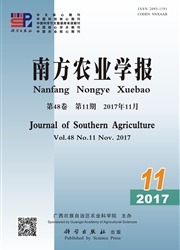

 中文摘要:
中文摘要:
【目的】探索国内大豆产业的发展潜力和发展空间,提高大豆的综合生产能力,实现大豆生产的可持续发展。【方法】利用1980~2012年我国10个大豆主产区大豆投入和产出的面板数据,采用加总数量框架下的乘积完备Hicks-Moorsteen TFP指数法,对我国大豆全要素生产率的增长进行测度,并提出相应的对策建议。【结果】1980~2012年,我国大豆全要素生产率(TFP)年均增长0.6%,大豆生产的技术进步年均增长1.7%,是大豆全要素生产率增长的主要驱动力;技术效率(TE)、混合效率(ME)和剩余规模效率(RSE)年均损失分别为0.5%、0.2%和0.4%;东北地区、西部地区和黄淮海地区的大豆生产TFP增长表现出依次递减的趋势,三大地区大豆生产技术效率均存在损失。【建议】应该加大大豆生产的投入力度、提高人力资本水平、大豆各生产区采取差异化策略、完善制度建设,以实现我国大豆生产可持续均衡发展。
 英文摘要:
英文摘要:
[Objective]In order to achieve sustainable development of soybean production, the development potential and space of soybean industry were studied to improve the comprehensive production capacity of soybean. [ Method ]Based on the panel data about input and output of 10 major soybean producing area in China during 1980-2012, the total factor productivity (TFP) growth of soybean in China was measured by using Hicks-Moorsteen TFP index method on the base of aggregate framework. Then the corresponding countermeasures and suggestions were put forward. [ Results ]During 1980- 2012, the average annual growth rate of soybean TFP was 0.6% and that of technical progress was 1.7%. The technical progress was the main driver of soybean TFP growth. The annual losses of technical efficiency (TE), mix efficiency(ME) and residual scale efficiency (RSE) were 0.5%, 0.2% and 0.4%, respectively, In addition, the TFP growth of northeast area, Huanghuaihai regions and western region of China were degressive in sequence. [ Suggestion ]Some suggestions have been put forward to achieve sustainable development of soybean production, including increasing investment, im- proving human capital level, taking differentiated strategy, and strengthening institutional construction.
 同期刊论文项目
同期刊论文项目
 同项目期刊论文
同项目期刊论文
 期刊信息
期刊信息
